An Open-Source Wireless Electrophysiological Complex for In Vivo Recording Neuronal Activity in the Rodent’s Brain
Abstract
:1. Introduction
- Small size and weight (15 × 10 × 10 mm; ~2 g);
- The possibility of using a multi-electrode array with a different number of recording channels;
- The ability to measure the impedance of electrodes;
- The ability to perform electrical stimulation;
- The possibility of using in optogenetics experiments (light stimulation);
- Wireless signal transmission;
- High data transfer rate (1 Mbps);
- Long battery life (at least 3 h).
2. Materials and Methods
2.1. Multi-Electrode Array
2.2. Wireless Module, Base Station, and Software
2.3. Firmware
2.4. Data Visualization and Recording Software
3. Results
3.1. Multi-Electrode Array
3.2. Wireless Module with Battery
3.3. Base Station
3.4. Data Visualization and Recording Software
- The ability to combine the settings of the selected graphs.
- The ability to change the names of the axes to units of time and voltage.
- The ability to display real-time data on the graphs and, in case of packet loss, reflect this in the graph.
- The ability to account for aliasing when forming graphs (if it is not already taken into account), and preferably smooth the curve.
- Fourier transform to estimate the signal spectrum for further analysis using third-party tools.
4. Conclusions
Author Contributions
Funding
Institutional Review Board Statement
Informed Consent Statement
Data Availability Statement
Conflicts of Interest
Appendix A
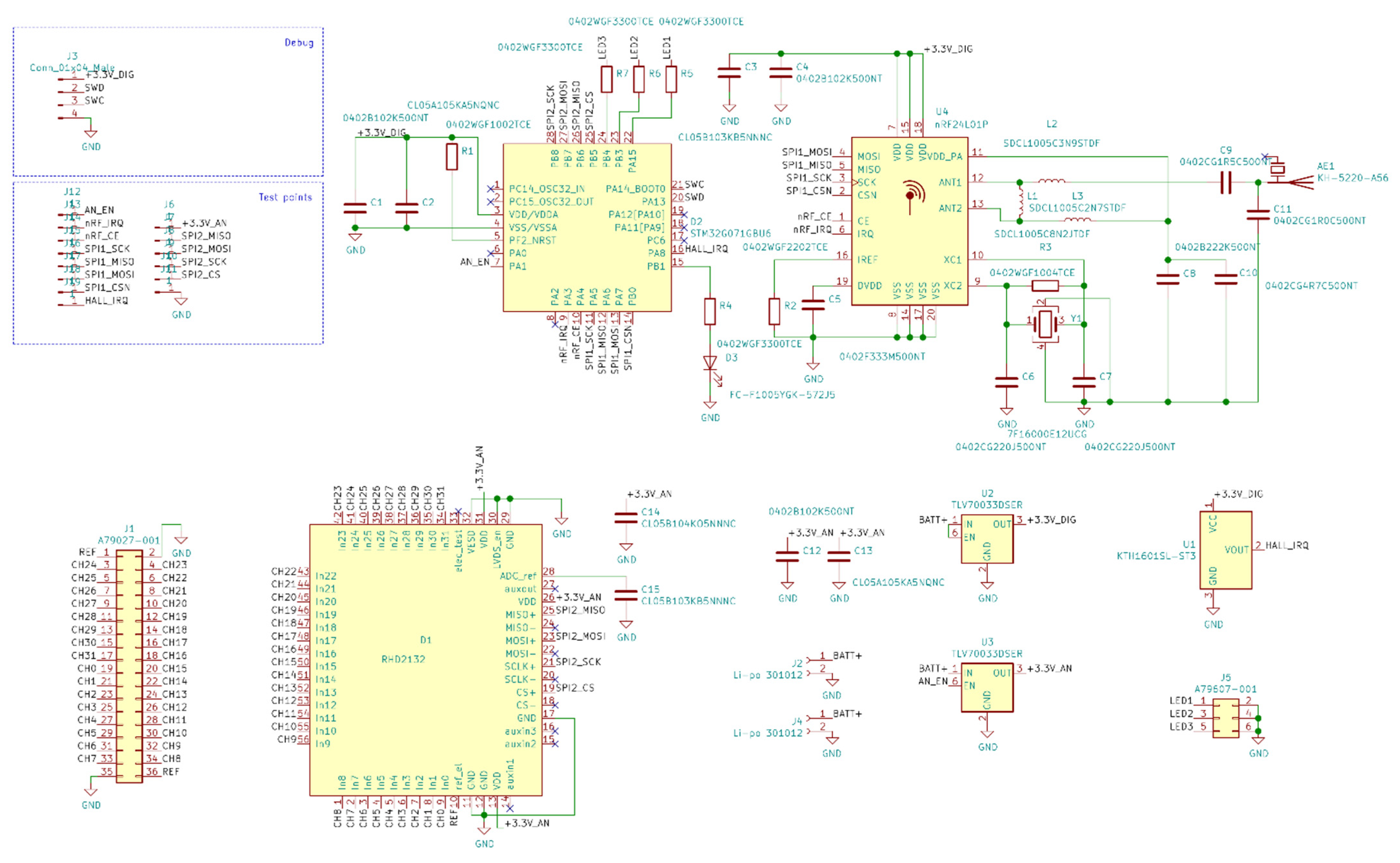
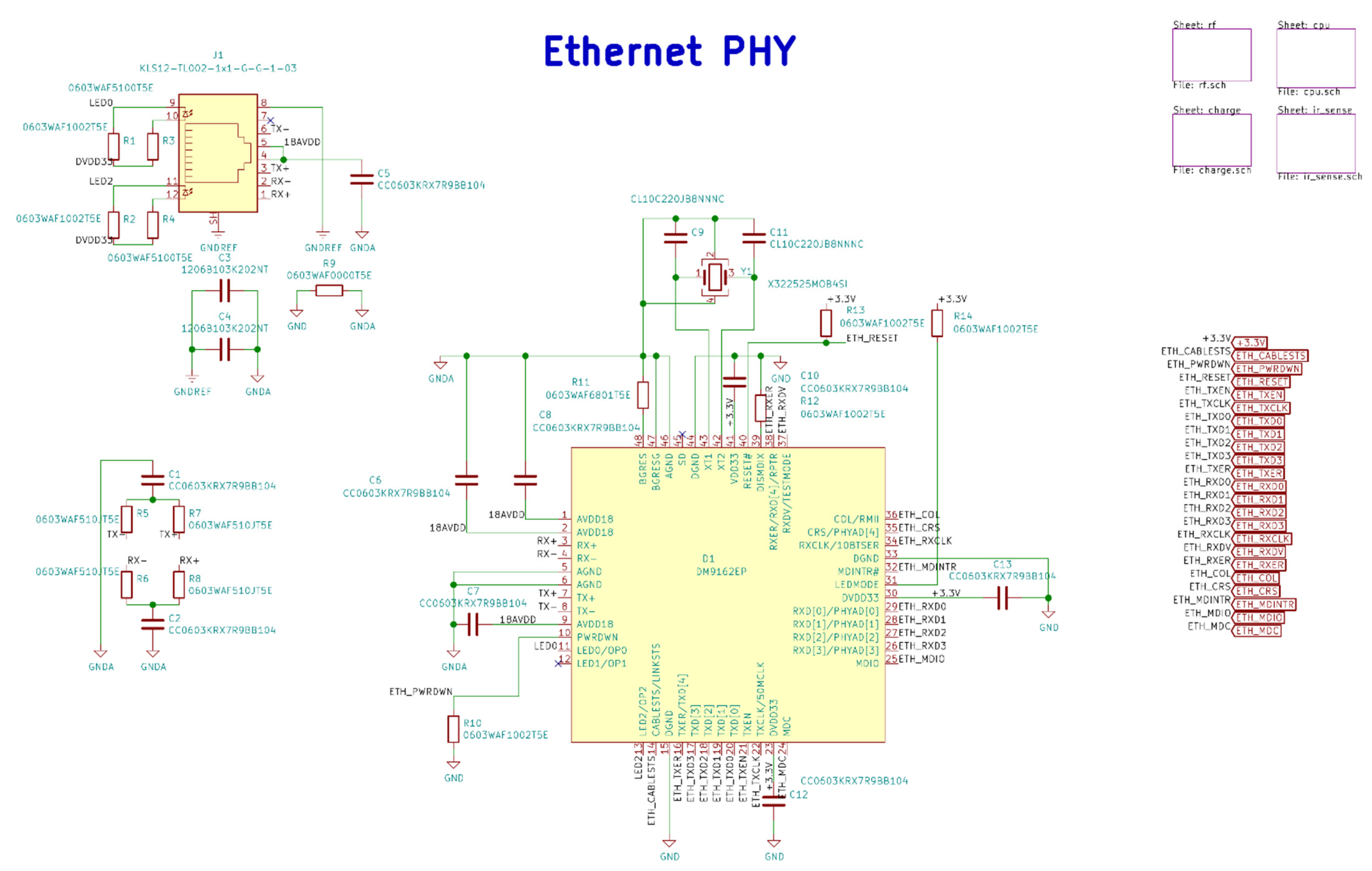
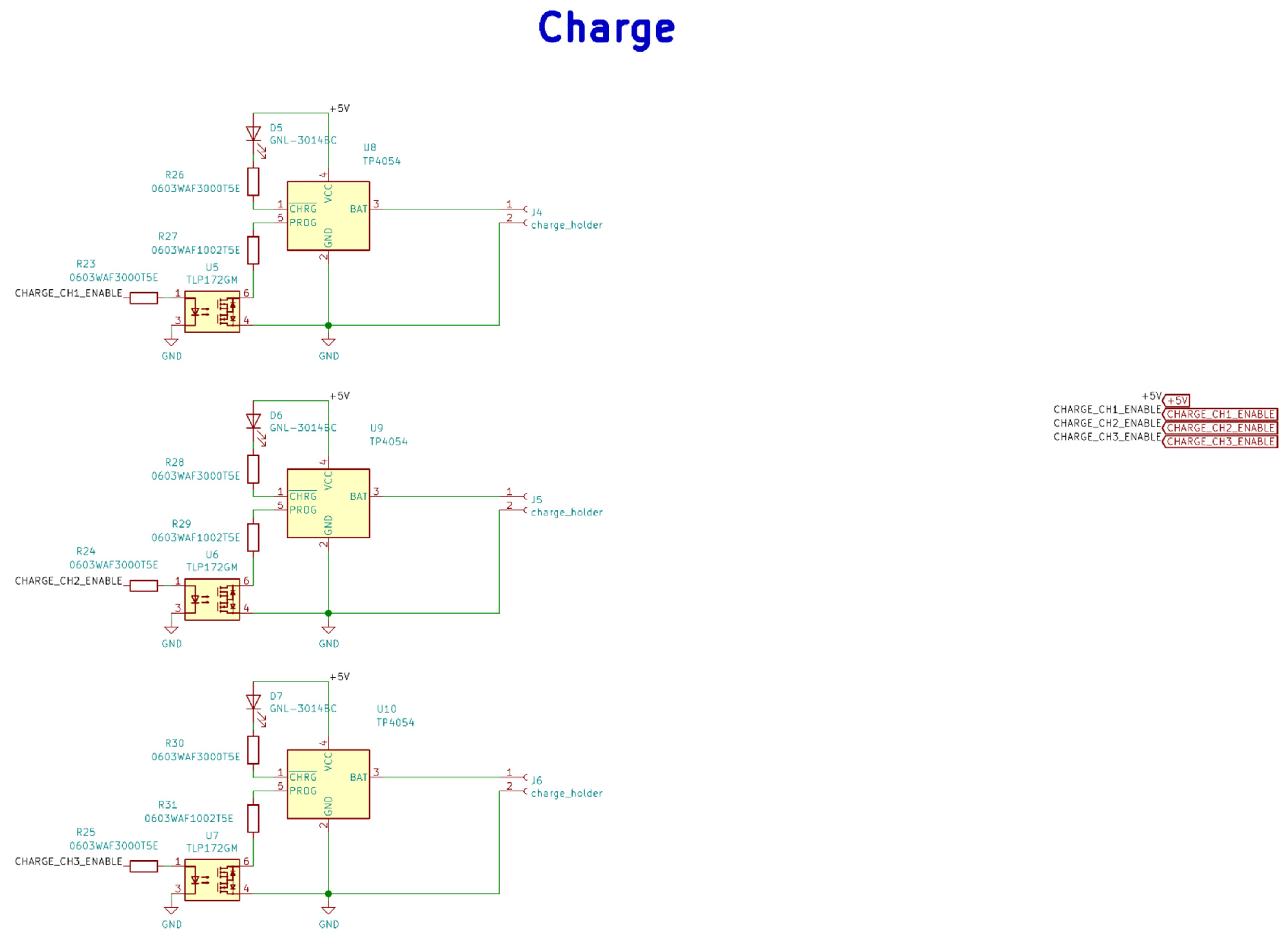

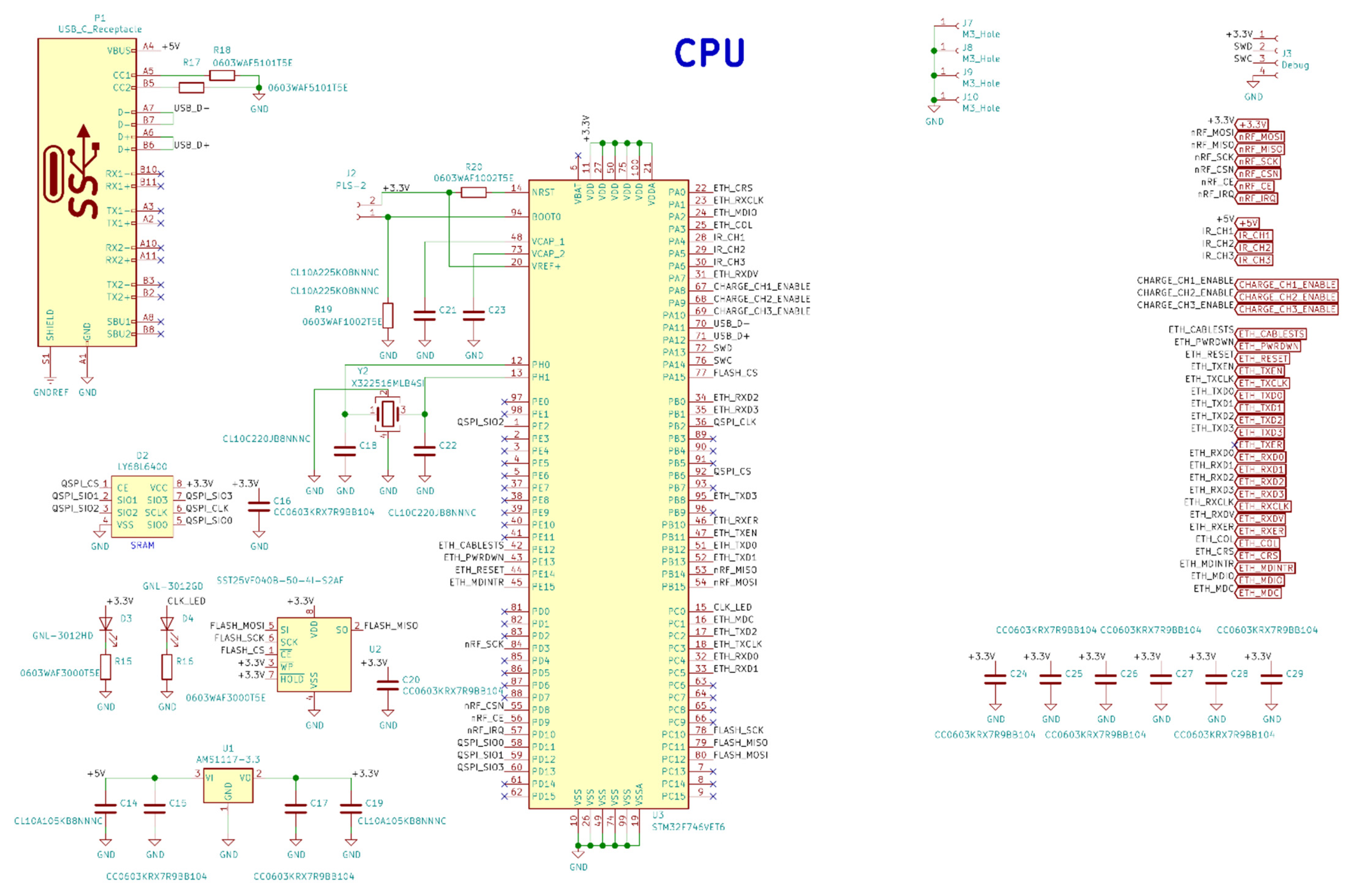

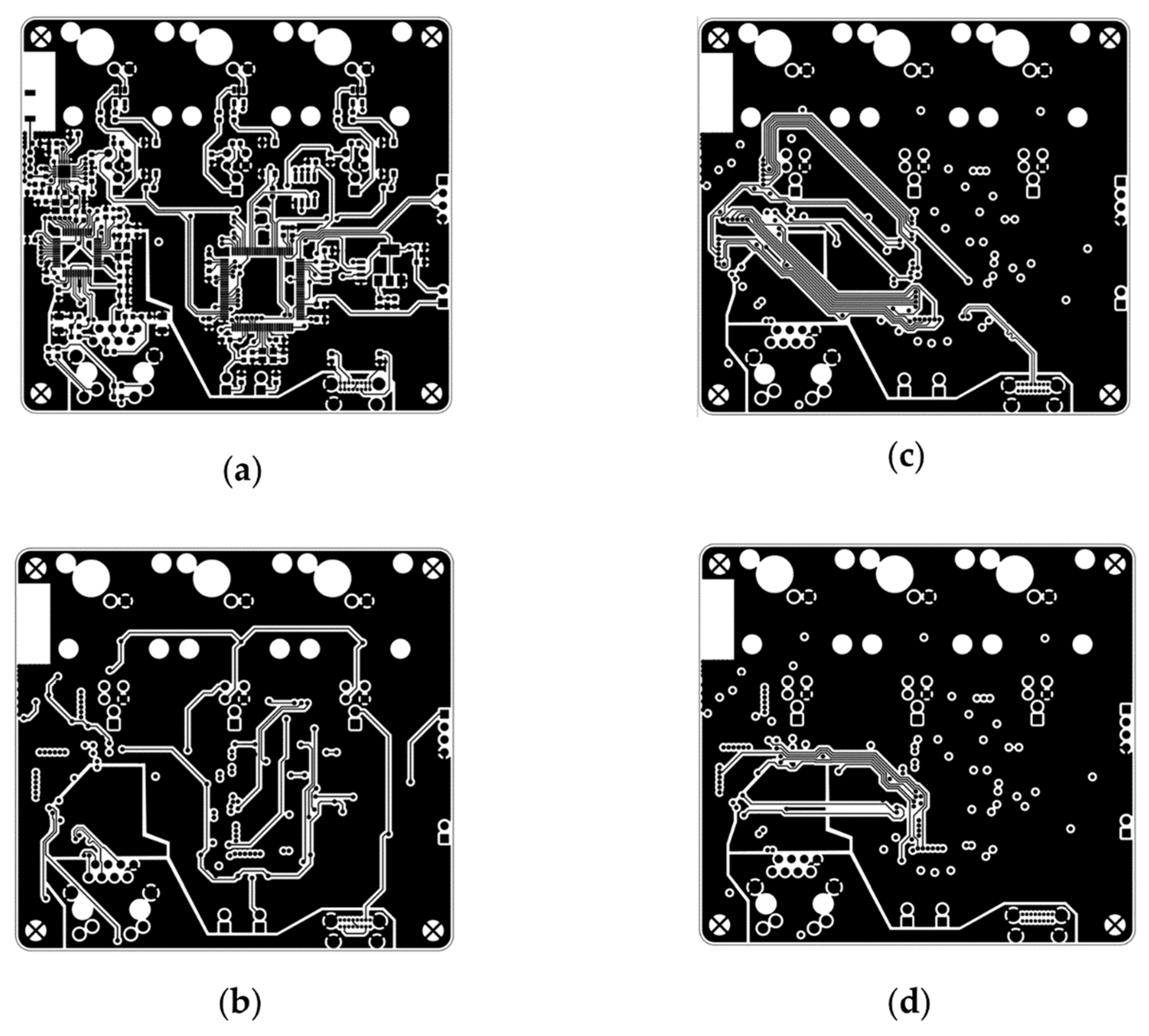
References
- Chong, S.A.; Benilova, I.; Shaban, H.; De Strooper, B.; Devijver, H.; Moechars, D.; Eberle, W.; Bartic, C.; Van Leuven, F.; Callewaert, G. Synaptic dysfunction in hippocampus of transgenic mouse models of Alzheimer’s disease: A multi-electrode array study. Neurobiol. Dis. 2011, 44, 284–291. [Google Scholar] [CrossRef]
- Yoo, J.; Kwak, H.; Kwon, J.; Ha, G.E.; Lee, E.H.; Song, S.; Na, J.; Lee, H.J.; Lee, J.; Hwangbo, A.; et al. Long-term Intracellular Recording of Optogenetically-induced Electrical Activities using Vertical Nanowire Multi Electrode Array. Sci. Rep. 2020, 10, 4279. [Google Scholar] [CrossRef] [Green Version]
- Szuts, T.A.; Fadeyev, V.; Kachiguine, S.; Sher, A.; Grivich, M.V.; Agrochao, M.; Hottowy, P.; Dabrowski, W.; Lubenov, E.V.; Siapas, A.G.; et al. A wireless multi-channel neural amplifier for freely moving animals. Nat. Neurosci. 2011, 14, 263–269. [Google Scholar] [CrossRef] [PubMed] [Green Version]
- Shen, J.; Colonnese, M.T. Development of Activity in the Mouse Visual Cortex. J. Neurosci. 2016, 36, 12259–12275. [Google Scholar] [CrossRef] [PubMed] [Green Version]
- Liu, Y.; McAfee, S.S.; Heck, D.H. Hippocampal sharp-wave ripples in awake mice are entrained by respiration. Sci Rep. 2017, 7, 8950. [Google Scholar] [CrossRef] [Green Version]
- Parker, R.A.; Davis, T.S.; House, P.A.; Normann, R.A.; Greger, B. The functional consequences of chronic, physiologically effective intracortical microstimulation. Prog Brain Res. 2011, 194, 145–165. [Google Scholar] [PubMed]
- Harris, A.Z.; Golder, D.; Likhtik, E. Multisite Electrophysiology Recordings in Mice to Study Cross-Regional Communication during Anxiety. Curr. Protoc. Neurosci. 2017, 80, 8–40. [Google Scholar] [CrossRef] [PubMed]
- Dzirasa, K.; Fuentes, R.; Kumar, S.; Potes, J.M.; Nicolelis, M.A. Chronic in vivo multi-circuit neurophysiological recordings in mice. J. Neurosci. Methods 2011, 195, 36–46. [Google Scholar] [CrossRef] [Green Version]
- Fan, D.; Rich, D.; Holtzman, T.; Ruther, P.; Dalley, J.W.; Lopez, A.; Rossi, M.A.; Barter, J.W.; Salas-Meza, D.; Herwik, S.; et al. A wireless multi-channel recording system for freely behaving mice and rats. PLoS ONE 2011, 6, e22033. [Google Scholar] [CrossRef] [Green Version]
- Roy, S.; Wang, X. Wireless multi-channel single unit recording in freely moving and vocalizing primates. J. Neurosci. Methods 2012, 203, 28–40. [Google Scholar] [CrossRef] [PubMed] [Green Version]
- Jou, A.Y.S.; Shan, H.Y.; Pajouhi, H.; Tsai, M.S.; Ghotbi, S.; Wu, Q.Y.; Chubykin, A.A.; Mohammadi, S. A Single-chip Wireless Microelectrode Array for Neural Recording and Stimulation. In Proceedings of the 2017 IEEE MTT-S International Microwave Symposium (IMS), Honololu, HI, USA, 4–9 June 2017; pp. 1244–1246. [Google Scholar]
- Herreras, O. Local Field Potentials: Myths and Misunderstandings. Front. Neural Circuits 2016, 10, 101. [Google Scholar] [CrossRef] [Green Version]
- Matveev, M.V.; Erofeev, A.I.; Terekhin, S.G.; Plotnikova, P.V.; Vorobyov, K.V.; Vlasova, O.L. Implantable devices for optogenetic studies and stimulation of excitable tissue. St. Petersburg Polytech. Univ. J. Phys. Math. 2015, 1, 264–271. [Google Scholar] [CrossRef] [Green Version]
- Dzirasa, K. Chronic Recordings in Transgenic Mice. In Methods for Neural Ensemble Recordings; Nicolelis, M.A.L., Ed.; CRC Press: Boca Raton, FL, USA, 2008. [Google Scholar]
- Brosch, M.; Deckert, M.; Rathi, S.; Takagaki, K.; Weidner, T.; Ohl, F.W.; Schmidt, B.; Lippert, M.T. An optically transparent multi-electrode array for combined electrophysiology and optophysiology at the mesoscopic scale. J. Neural Eng. 2020, 17, 046014. [Google Scholar] [CrossRef] [PubMed]
- Wu, X.; Yang, X.; Song, L.; Wang, Y.; Li, Y.; Liu, Y.; Yang, X.; Wang, Y.; Pei, W.; Li, W. A Modified Miniscope System for Simultaneous Electrophysiology and Calcium Imaging in vivo. Front. Integr. Neurosci. 2021, 15, 682019. [Google Scholar] [CrossRef]
- Aqrawe, Z.; Montgomery, J.; Travas-Sejdic, J.; Svirskis, D. Conducting Polymers as Electrode Coatings for Neuronal Multi-electrode Arrays. Trends Biotechnol. 2017, 35, 93–95. [Google Scholar] [CrossRef] [PubMed]
- Dong, R.; Liu, X.; Cheng, S.; Tang, L.; Chen, M.; Zhong, L.; Chen, Z.; Liu, S.; Jiang, X. Highly Stretchable Metal-Polymer Conductor Electrode Array for Electrophysiology. Adv. Healthc. Mater. 2021, 10, e2000641. [Google Scholar] [CrossRef] [PubMed]
- Yi, W.; Chen, C.; Feng, Z.; Xu, Y.; Zhou, C.; Masurkar, N.; Cavanaugh, J.; Cheng, M.M. A flexible and implantable microelectrode arrays using high-temperature grown vertical carbon nanotubes and a biocompatible polymer substrate. Nanotechnology 2015, 26, 125301. [Google Scholar] [CrossRef]
- Ingrole, R.S.J.; Gill, H.S. Microneedle Coating Methods: A Review with a Perspective. J. Pharmacol. Exp. Ther. 2019, 370, 555–569. [Google Scholar] [CrossRef]
- Torres-Martinez, N.; Ratel, D.; Cretallaz, C.; Gaude, C.; Maubert, S.; Divoux, J.L.; Henry, C.; Guiraud, D.; Sauter-Starace, F. Reliability of parylene-based multi-electrode arrays chronically implanted in adult rat brains, and evidence of electrical stimulation on contact impedance. J. Neural Eng. 2019, 16, 066047. [Google Scholar] [CrossRef] [Green Version]
- Xu, H.; Hirschberg, A.W.; Scholten, K.; Meng, E.; Berger, T.W.; Song, D. Application of Parylene-Based Flexible Multi-Electrode Array for Recording From Subcortical Brain Regions From Behaving Rats. In Proceedings of the 2018 40th Annual International Conference of the IEEE Engineering in Medicine and Biology Society (EMBC), Honolulu, HI, USA, 17–20 July 2018; Volume 2018, pp. 4599–4602. [Google Scholar]
- Chung, J.E.; Joo, H.R.; Fan, J.L.; Liu, D.F.; Barnett, A.H.; Chen, S.; Geaghan-Breiner, C.; Karlsson, M.P.; Karlsson, M.; Lee, K.Y.; et al. High-Density, Long-Lasting, and Multi-region Electrophysiological Recordings Using Polymer Electrode Arrays. Neuron 2019, 101, 21–31. [Google Scholar] [CrossRef]
- Winkin, N.; Mokwa, W. Flexible multi-electrode array with integrated bendable CMOS-chip for implantable systems. In Proceedings of the 2012 Annual International Conference of the IEEE Engineering in Medicine and Biology Society, San Diego, CA, USA, 28 August–1 September 2012; Volume 2012, pp. 3882–3885. [Google Scholar]
- Ochoa, M.; Wei, P.; Wolley, A.J.; Otto, K.J.; Ziaie, B. A hybrid PDMS-Parylene subdural multi-electrode array. Biomed. Microdevices 2013, 15, 437–443. [Google Scholar] [CrossRef] [Green Version]
- Lefebvre, B.; Yger, P.; Marre, O. Recent progress in multi-electrode spike sorting methods. J. Physiol. Paris 2016, 110, 327–335. [Google Scholar] [CrossRef] [PubMed] [Green Version]
- Buccino, A.P.; Hagen, E.; Einevoll, G.T.; Hafliger, P.D.; Cauwenbergh, G. Independent Component Analysis for Fully Automated Multi-Electrode Array Spike Sorting. In Proceedings of the 2018 40th Annual International Conference of the IEEE Engineering in Medicine and Biology Society (EMBC), Honolulu, HI, USA, 17–20 July 2018; Volume 2018, pp. 2627–2630. [Google Scholar]
- Siegle, J.H.; Lopez, A.C.; Patel, Y.A.; Abramov, K.; Ohayon, S.; Voigts, J. Open Ephys: An open-source, plugin-based platform for multichannel electrophysiology. J. Neural Eng. 2017, 14, 045003. [Google Scholar] [CrossRef] [PubMed]
- Nasiotis, K.; Cousineau, M.; Tadel, F.; Peyrache, A.; Leahy, R.M.; Pack, C.C.; Baillet, S. Integrated open-source software for multiscale electrophysiology. Sci. Data 2019, 6, 231. [Google Scholar] [CrossRef] [Green Version]
- Campagnola, L.; Kratz, M.B.; Manis, P.B. ACQ4: An open-source software platform for data acquisition and analysis in neurophysiology research. Front. Neuroinform. 2014, 8, 3. [Google Scholar] [CrossRef]
- Rothman, J.S.; Silver, R.A. NeuroMatic: An Integrated Open-Source Software Toolkit for Acquisition, Analysis and Simulation of Electrophysiological Data. Front. Neuroinform. 2018, 12, 14. [Google Scholar] [CrossRef]
- Spacek, M.; Blanche, T.; Swindale, N. Python for large-scale electrophysiology. Front. Neuroinform. 2008, 2, 9. [Google Scholar] [CrossRef] [Green Version]
- Georgiadis, V.; Stephanou, A.; Townsend, P.A.; Jackson, T.R. MultiElec: A MATLAB Based Application for MEA Data Analysis. PLoS ONE 2015, 10, e0129389. [Google Scholar] [CrossRef] [PubMed]
- Egert, U.; Knott, T.; Schwarz, C.; Nawrot, M.; Brandt, A.; Rotter, S.; Diesmann, M. MEA-Tools: An open source toolbox for the analysis of multi-electrode data with MATLAB. J. Neurosci. Methods 2002, 117, 33–42. [Google Scholar] [CrossRef]
- Rolston, J.D.; Gross, R.E.; Potter, S.M. NeuroRighter: Closed-loop multielectrode stimulation and recording for freely moving animals and cell cultures. In Proceedings of the 2009 Annual International Conference of the IEEE Engineering in Medicine and Biology Society, Minneapolis, MN, USA, 3–6 September 2009; Volume 2009, pp. 6489–6492. [Google Scholar]
- Gelfman, S.; Wang, Q.; Lu, Y.F.; Hall, D.; Bostick, C.D.; Dhindsa, R.; Halvorsen, M.; McSweeney, K.M.; Cotterill, E.; Edinburgh, T.; et al. meaRtools: An R package for the analysis of neuronal networks recorded on microelectrode arrays. PLoS Comput. Biol. 2018, 14, e1006506. [Google Scholar] [CrossRef] [Green Version]
- Suter, B.A.; O’Connor, T.; Iyer, V.; Petreanu, L.T.; Hooks, B.M.; Kiritani, T.; Svoboda, K.; Shepherd, G.M. Ephus: Multipurpose data acquisition software for neuroscience experiments. Front. Neural Circuits 2010, 4, 100. [Google Scholar] [CrossRef] [PubMed] [Green Version]
- Putzeys, J.; Raducanu, B.C.; Carton, A.; De Ceulaer, J.; Karsh, B.; Siegle, J.H.; Van Helleputte, N.; Harris, T.D.; Dutta, B.; Musa, S.; et al. Neuropixels Data-Acquisition System: A Scalable Platform for Parallel Recording of 10 000+ Electrophysiological Signals. IEEE Trans. Biomed. Circuits Syst. 2019, 13, 1635–1644. [Google Scholar] [CrossRef] [PubMed]
- Ghomashchi, A.; Zheng, Z.; Majaj, N.; Trumpis, M.; Kiorpes, L.; Viventi, J. A low-cost, open-source, wireless electrophysiology system. In Proceedings of the 2014 36th Annual International Conference of the IEEE Engineering in Medicine and Biology Society, Chicago, IL, USA, 27–31 August 2014; Volume 2014, pp. 3138–3141. [Google Scholar]
- Englitz, B.; David, S.V.; Sorenson, M.D.; Shamma, S.A. MANTA—An open-source, high density electrophysiology recording suite for MATLAB. Front. Neural Circuits 2013, 7, 69. [Google Scholar] [CrossRef] [PubMed] [Green Version]
- Cheng, N.; Murari, K. OSERR: An open-source standalone electrophysiology recording system for rodents. Sci Rep. 2020, 10, 16996. [Google Scholar] [CrossRef] [PubMed]
- Wang, J.; Trumpis, M.; Insanally, M.; Froemke, R.; Viventi, J. A low-cost, multiplexed electrophysiology system for chronic muECoG recordings in rodents. In Proceedings of the 2014 36th Annual International Conference of the IEEE Engineering in Medicine and Biology Society, Chicago, IL, USA, 27–31 August 2014; Volume 2014, pp. 5256–5259. [Google Scholar]
- Garma, L.D.; Matino, L.; Melle, G.; Moia, F.; De Angelis, F.; Santoro, F.; Dipalo, M. Cost-effective and multifunctional acquisition system for in vitro electrophysiological investigations with multi-electrode arrays. PLoS ONE 2019, 14, e0214017. [Google Scholar] [CrossRef]
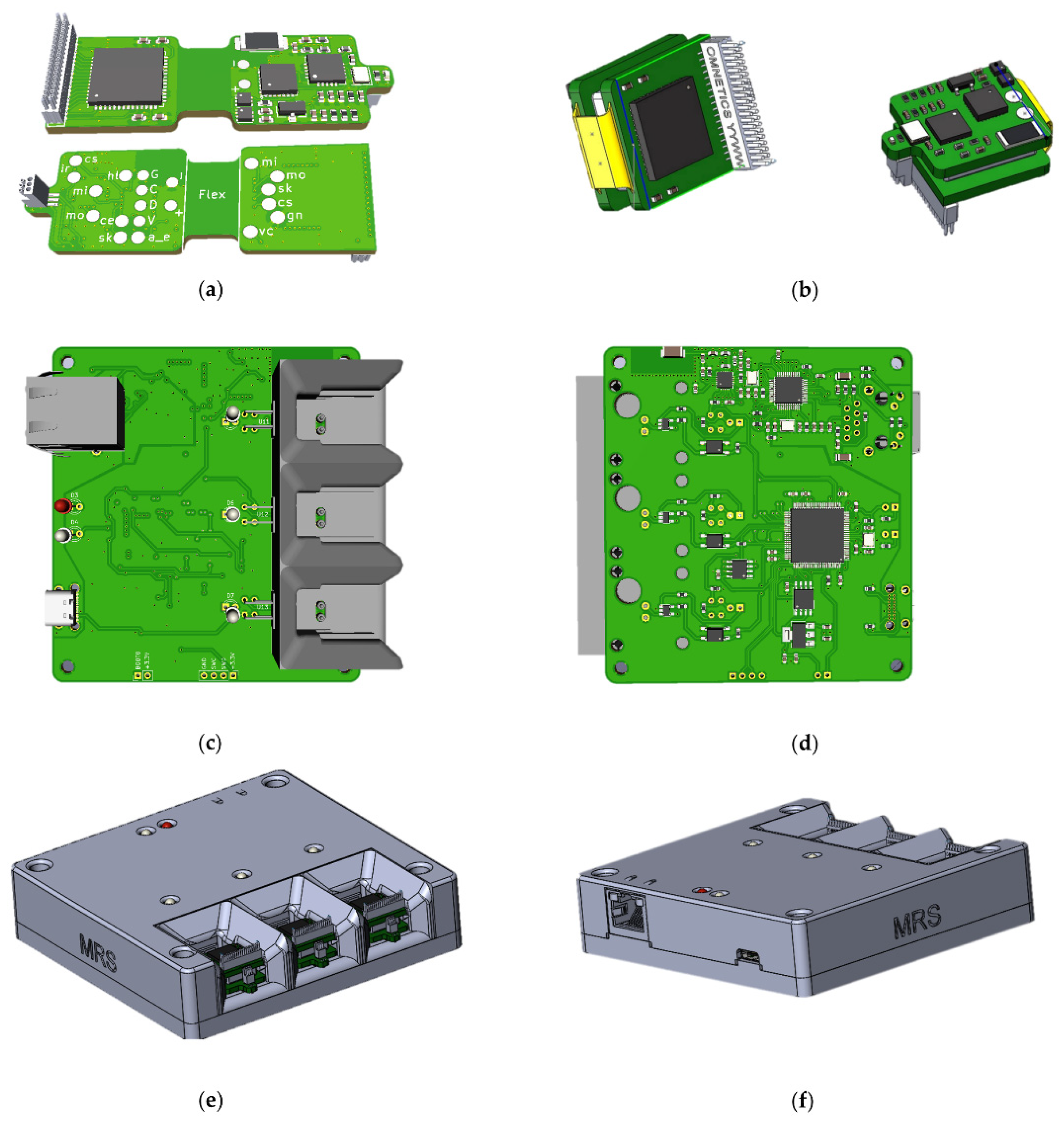
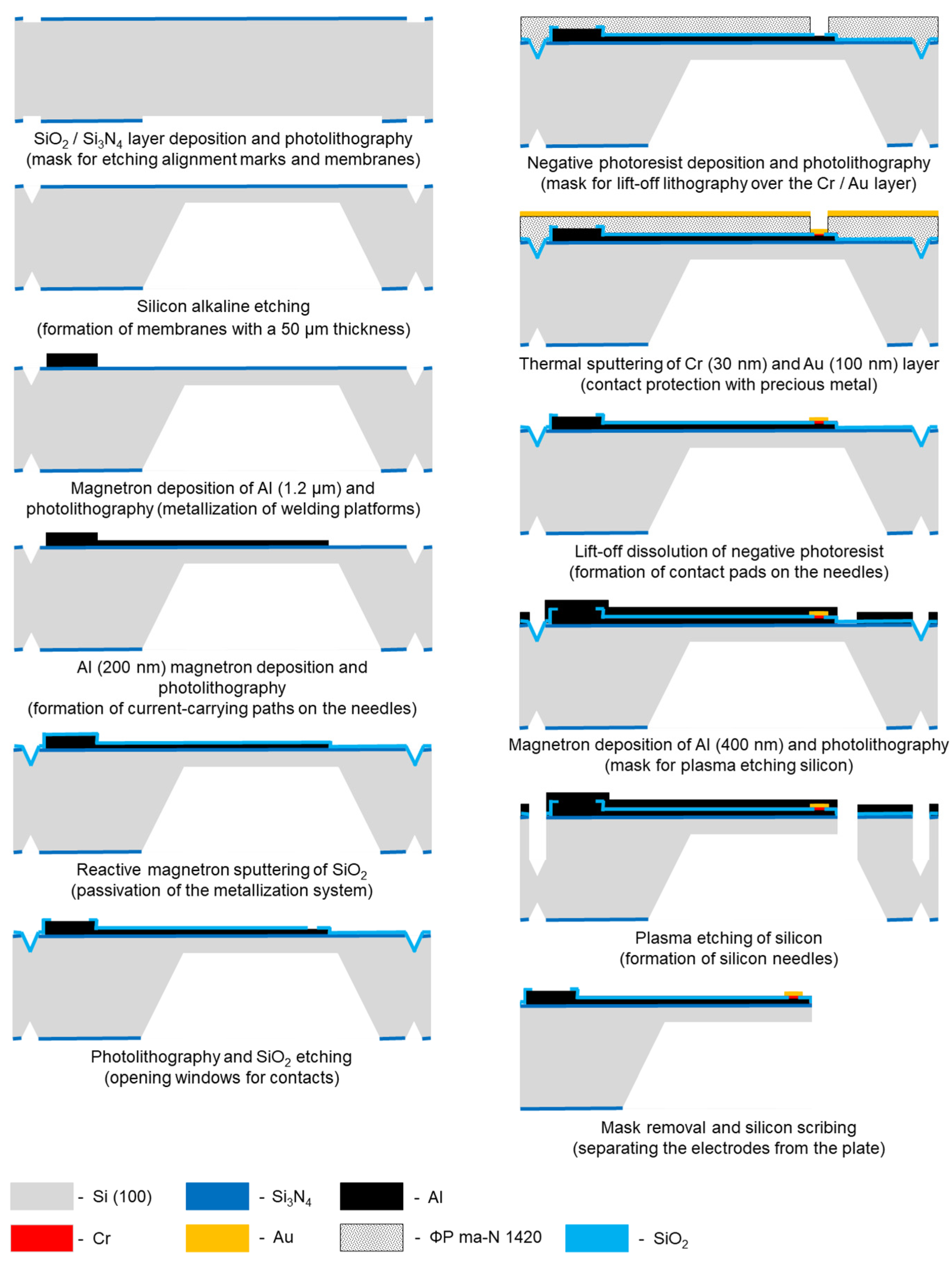
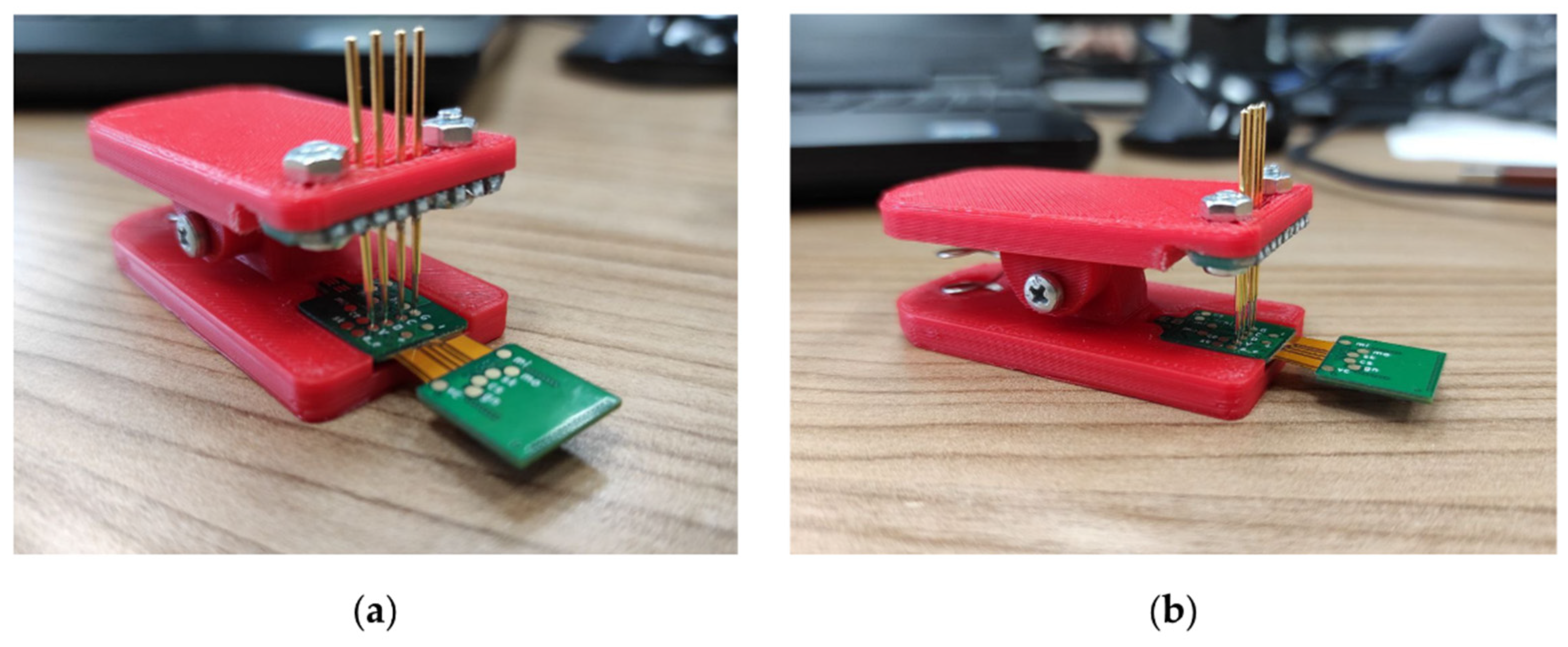
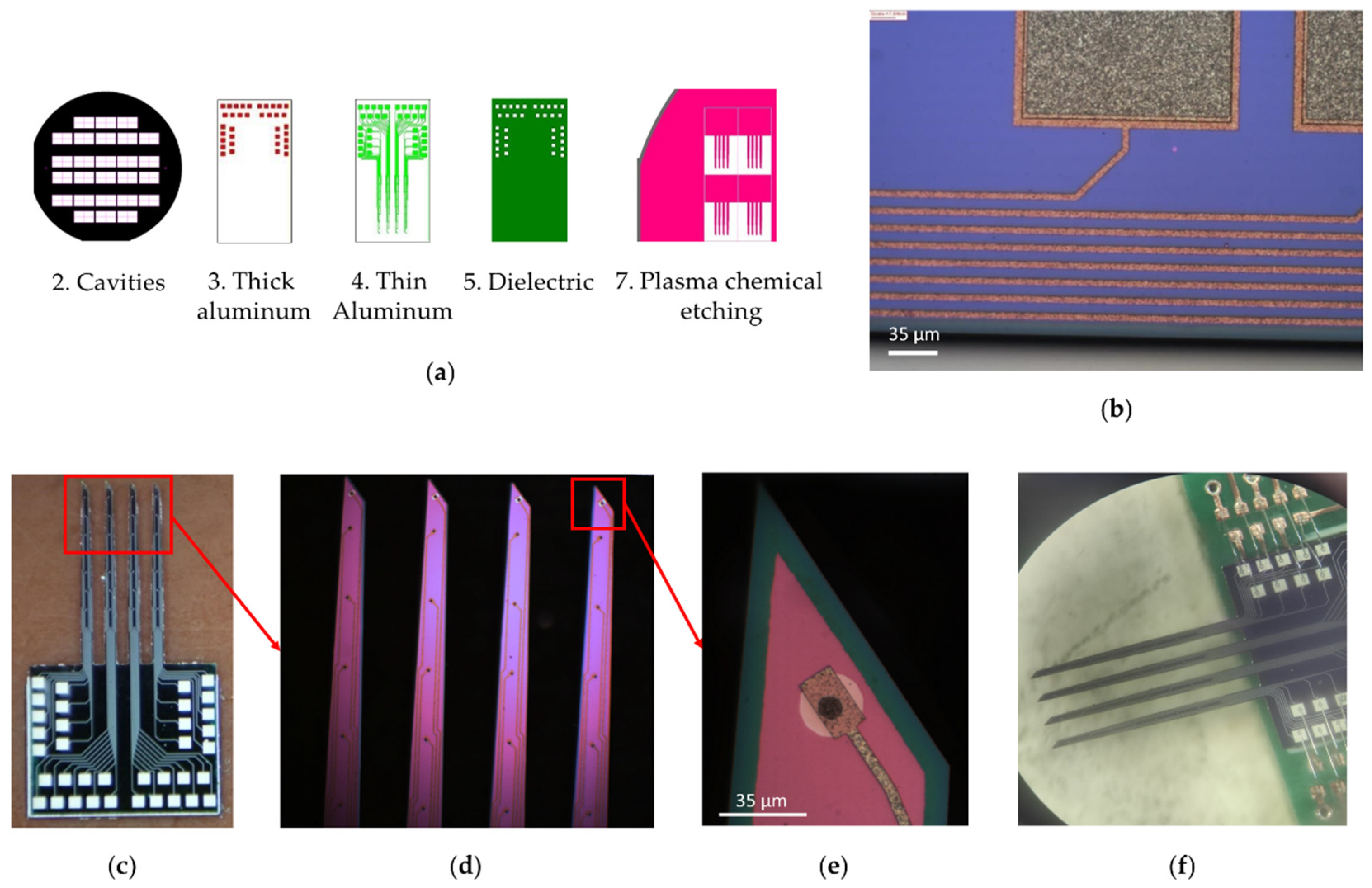
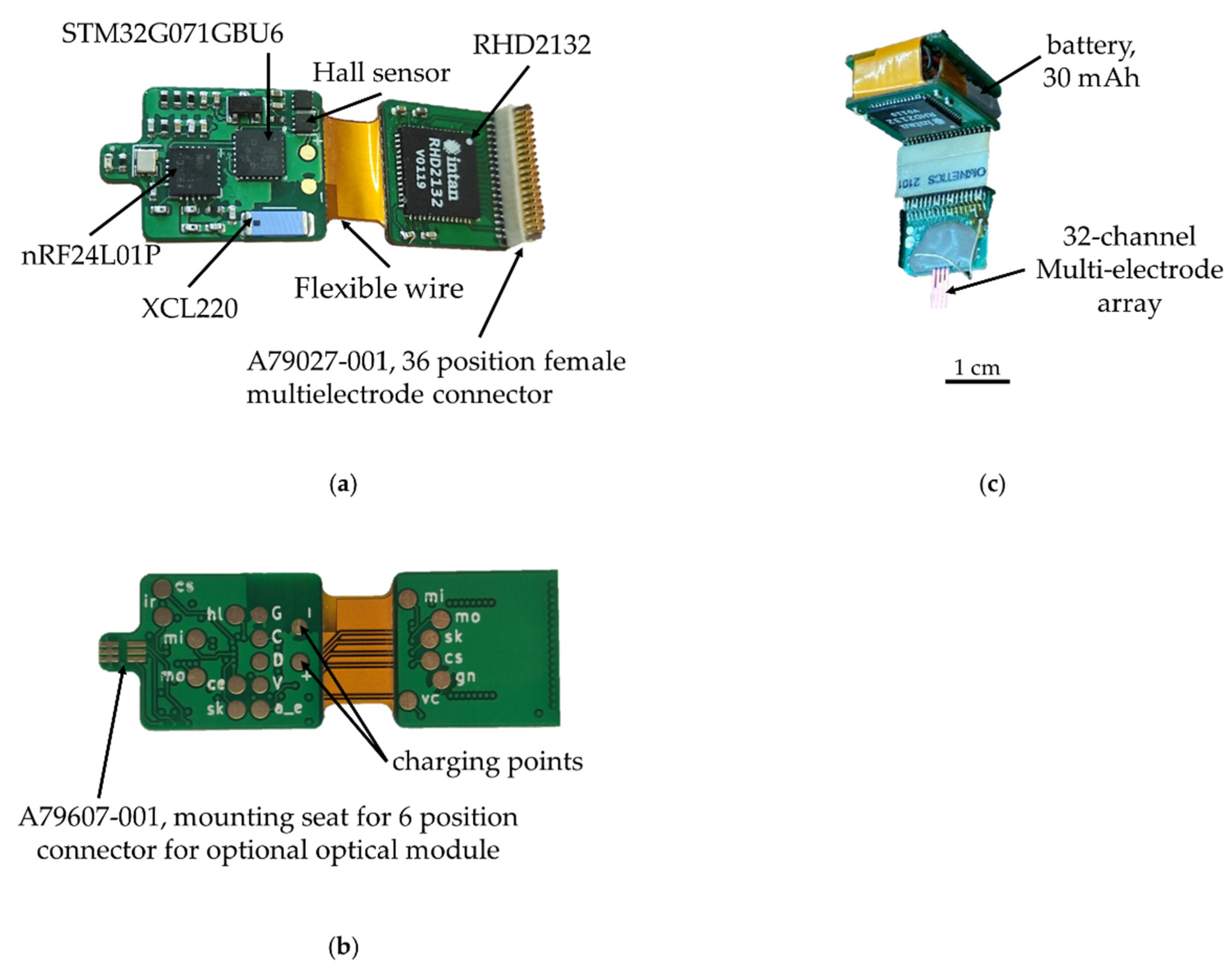


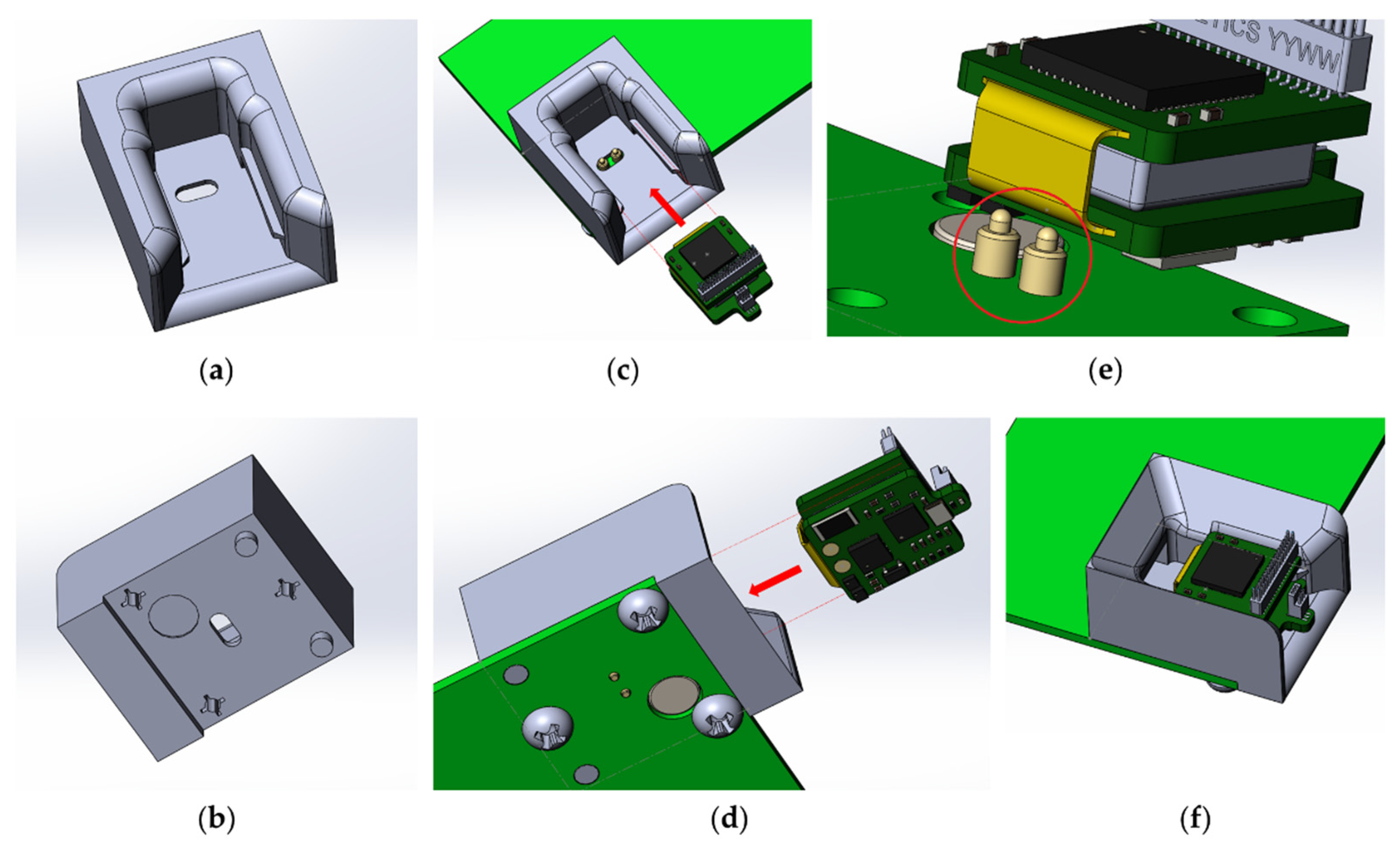
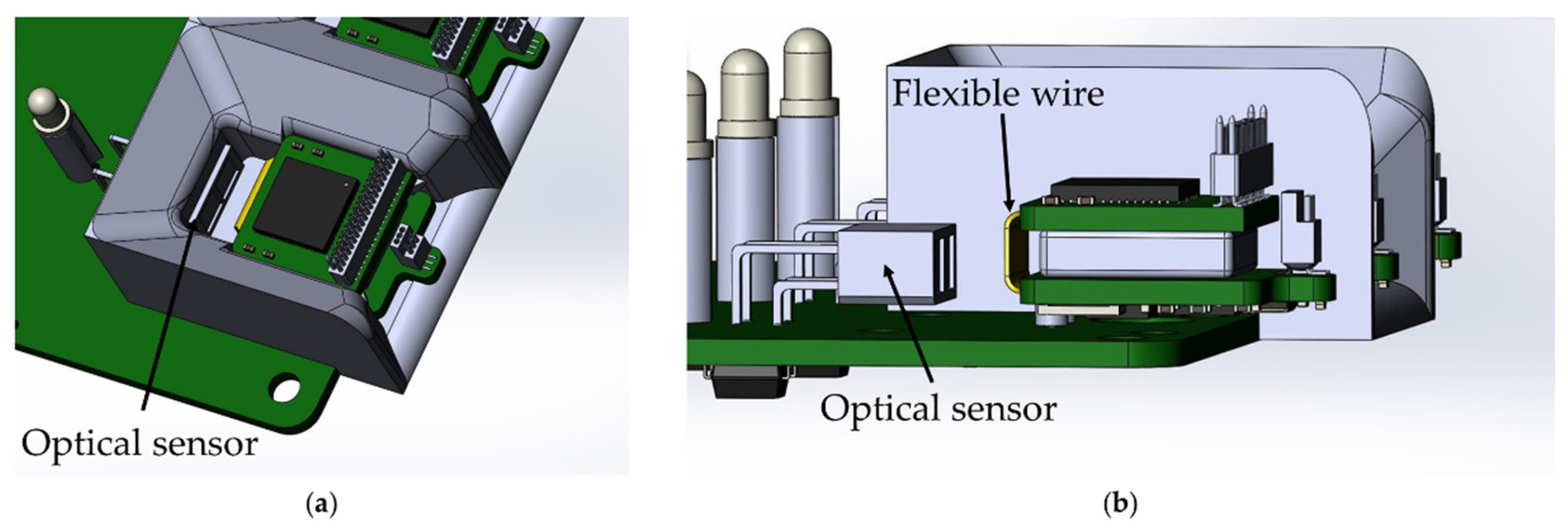
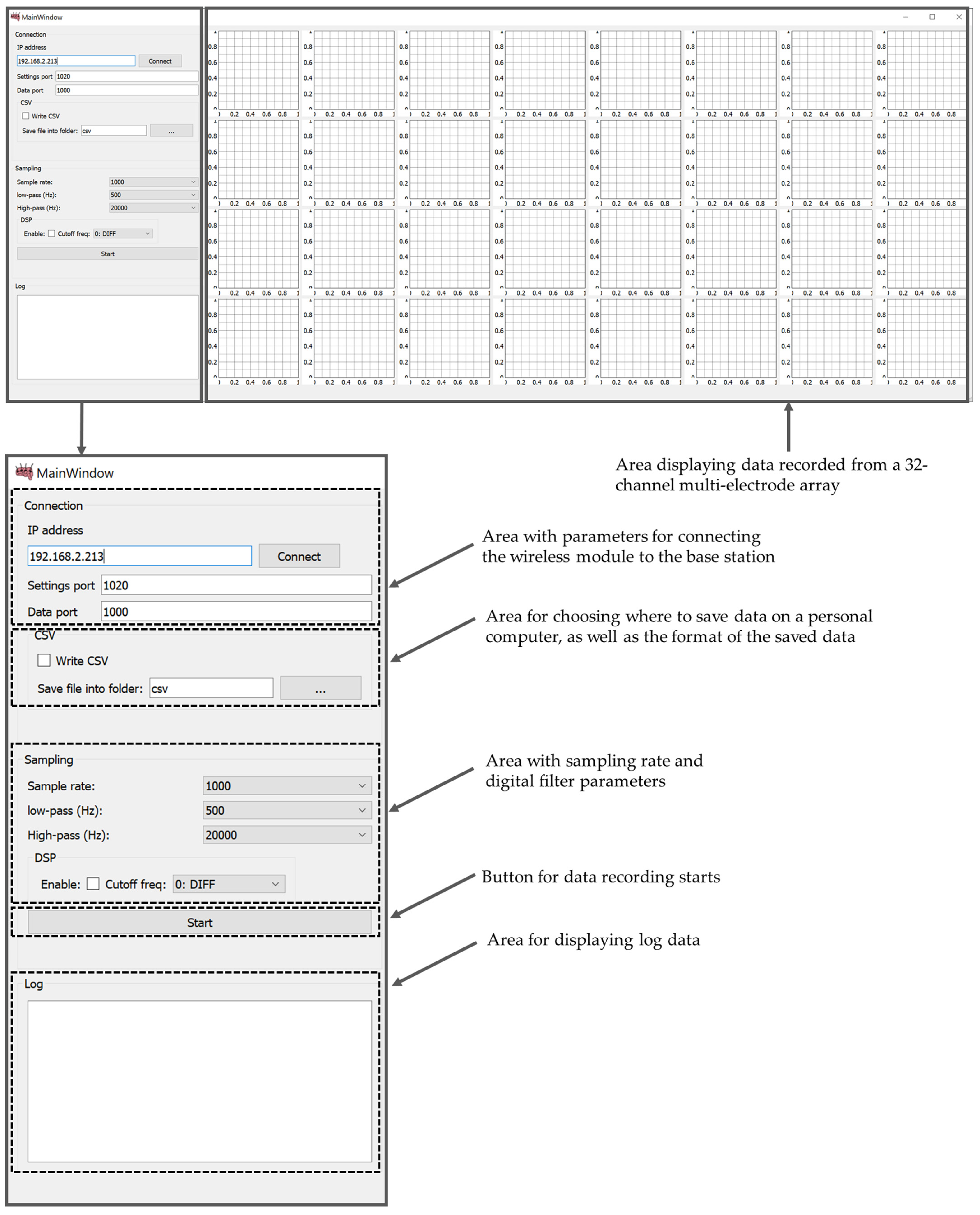
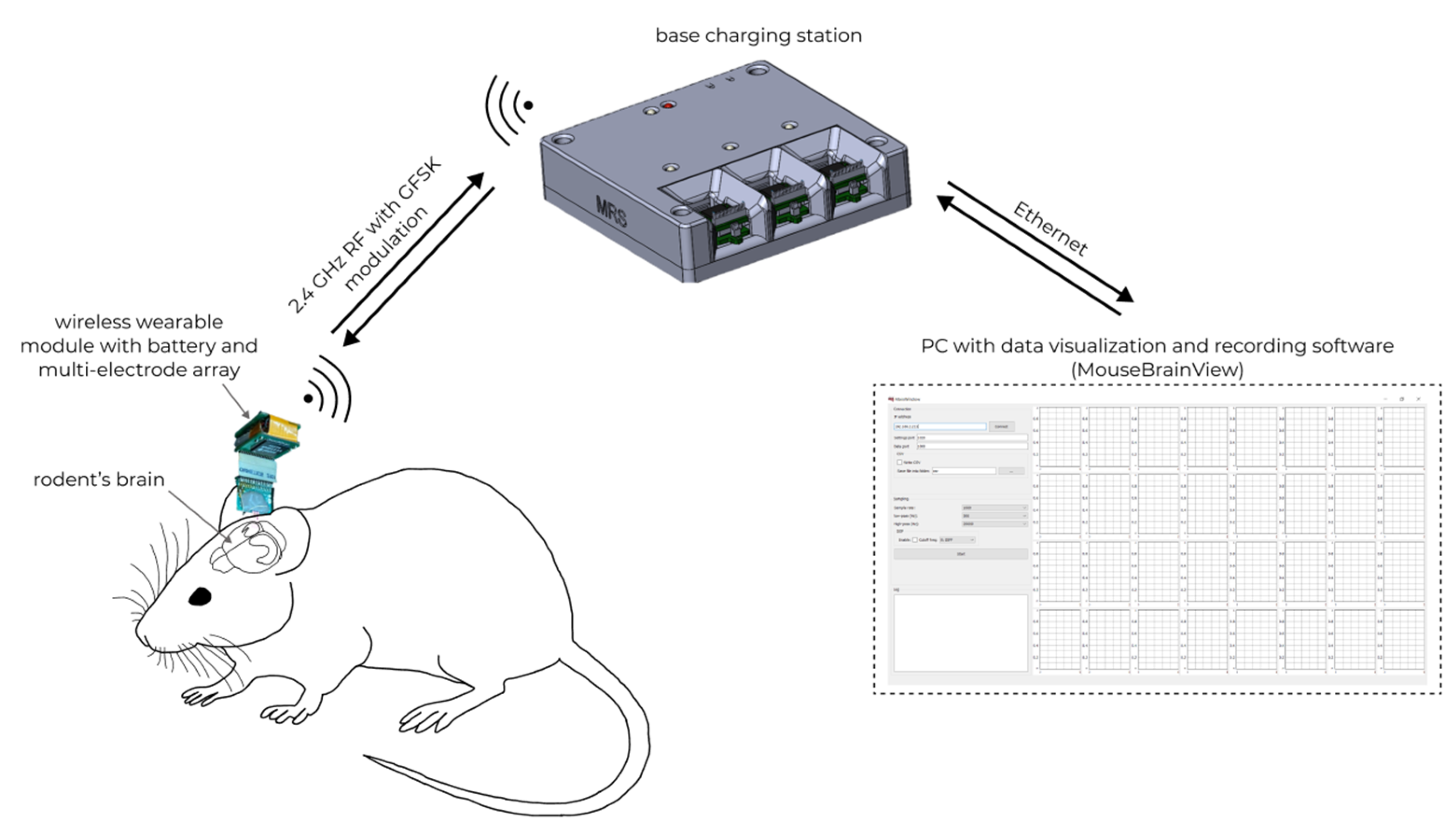
| N° | Name | Receiver Size, L × W × H, mm | Receiver Weight (g) | Number of Registration Channels | Measuring the Impedance of the Electrodes | Electrical Stimulation | Light Stimulation | Wireless | Data Transfer Rate (kbit) | Disadvantages Compared to an Open-Source Wireless Electrophysiological Complex |
|---|---|---|---|---|---|---|---|---|---|---|
| 1 | Multichannel Systems W2100 | 13 × 13 × 5.5–15.5 × 15.5 × 6.7 | 1.9–3.7 | 4, 8, 16, 32 | − | + | + | + | NA | lack of measuring the impedance of the electrodes |
| 2 | Jaga Penny | 24 × 15.4 × 3 | 1.2–12 | 16 | − | − | − | + | NA | larger size with a smaller number of registration channels |
| 3 | Blackrock Micro Wireless Headstage | 35 × 35 × 35 | NA | Up to 96 | − | + | NA | + | NA | lack of measuring the impedance of the electrodes, larger size |
| 4 | BioRadio Profi Set. Wireless | 100 × 60 × 20 | NA | 8 | − | − | − | + | 200 | larger size with a smaller number of registration channels, low data transfer rate |
| 5 | TaiNi | 19 × 14.5 × 15 | 1.5 | Up to 32 | − | − | − | + | 400 | ASIC-based, hard to customize |
| 7 | Teleopto Wireless Optogenetics | 13 × 18 × 7 | 1.4 | − | − | − | + | + | − | no registration function |
| 8 | Neurolux | 11.5 × 10.5 × 1.3 | 0.03 | − | − | − | + | + | − | no registration function |
| 9 | An open-source wireless electrophysiological complex | 10 × 10 × 15 | ~2 | Up to 32 | + | in future versions | in future versions | + | 1000 |
| Name | Manufacturer | Description |
|---|---|---|
| nRF24L01P | Nordic Semiconductor, Trondheim, Norway | 2.4 GHz, 2 Mbit/s, 4 × 4 × 0.8 mm, digital receiver transmitter with GFSK modulation, 126 frequency channels, and configurable transmitter power |
| STM32G071GBU6 | STMicroelectronics, Geneva, Switzerland | 4 × 4 × 0.6 mm, microcontroller |
| RHD2132 | Intan Technologies, Los Angeles, CA, USA | an electrophysiology 32-channel amplifier chip with unipolar inputs and common reference |
| A79027-001 | Omnetics, Minneapolis, MN, USA | 36-channel connector for connecting to a 32-channel multi-electrode array |
| A79607-001 | Omnetics, Minneapolis, MN, USA | connector for connection to an optical probe |
| LP301012 | Akyga battery, Wroclaw, Poland | 30 mAh 3.7 V, li-ion battery |
| Name | Manufacturer | Description |
|---|---|---|
| nRF24L01P | Nordic Semiconductor, Trondheim, Norway | 2.4 GHz, 2 Mbit/s, 4 × 4 × 0.8 mm, digital receiver transmitter with GFSK modulation, 126 frequency channels, and configurable transmitter power |
| STM32F746VET6 | STMicroelectronics, Geneva, Switzerland | microcontroller |
| DM9162EP | Davicom Semiconductor, Hsinchu, Taiwan | physical layer controller for Ethernet |
| TP4054 | STMicroelectronics, Geneva, Switzerland | charge controller for Li-ion batteries |
| ITR-9909 | Everlight Electronics, Xinbei, Taiwan | an infrared LED and a phototransistor |
Publisher’s Note: MDPI stays neutral with regard to jurisdictional claims in published maps and institutional affiliations. |
© 2021 by the authors. Licensee MDPI, Basel, Switzerland. This article is an open access article distributed under the terms and conditions of the Creative Commons Attribution (CC BY) license (https://creativecommons.org/licenses/by/4.0/).
Share and Cite
Erofeev, A.; Kazakov, D.; Makarevich, N.; Bolshakova, A.; Gerasimov, E.; Nekrasov, A.; Kazakin, A.; Komarevtsev, I.; Bolsunovskaja, M.; Bezprozvanny, I.; et al. An Open-Source Wireless Electrophysiological Complex for In Vivo Recording Neuronal Activity in the Rodent’s Brain. Sensors 2021, 21, 7189. https://doi.org/10.3390/s21217189
Erofeev A, Kazakov D, Makarevich N, Bolshakova A, Gerasimov E, Nekrasov A, Kazakin A, Komarevtsev I, Bolsunovskaja M, Bezprozvanny I, et al. An Open-Source Wireless Electrophysiological Complex for In Vivo Recording Neuronal Activity in the Rodent’s Brain. Sensors. 2021; 21(21):7189. https://doi.org/10.3390/s21217189
Chicago/Turabian StyleErofeev, Alexander, Dmitriy Kazakov, Nikita Makarevich, Anastasia Bolshakova, Evgenii Gerasimov, Arseniy Nekrasov, Alexey Kazakin, Ivan Komarevtsev, Marina Bolsunovskaja, Ilya Bezprozvanny, and et al. 2021. "An Open-Source Wireless Electrophysiological Complex for In Vivo Recording Neuronal Activity in the Rodent’s Brain" Sensors 21, no. 21: 7189. https://doi.org/10.3390/s21217189
APA StyleErofeev, A., Kazakov, D., Makarevich, N., Bolshakova, A., Gerasimov, E., Nekrasov, A., Kazakin, A., Komarevtsev, I., Bolsunovskaja, M., Bezprozvanny, I., & Vlasova, O. (2021). An Open-Source Wireless Electrophysiological Complex for In Vivo Recording Neuronal Activity in the Rodent’s Brain. Sensors, 21(21), 7189. https://doi.org/10.3390/s21217189







